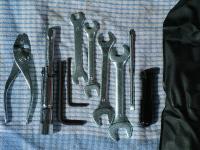My spec of 10nM was not for the little 4mm JIS (cross headed) screws that hold the reservoir lid on. Those screws do not have a torque spec in the FSM. They merely compress the rubber gasket under the lid so, as others have said, "snug" is fine. A
generic spec for a 4mm screw in an alloy thread would be around 10 in-lbs. But don't try measuring that with your 3/8" drive torque wrench. You'll need a wrench with a scale more appropriate to the measurement. Torque wrenches that small are usually of a screw-driver design. Yes I do own one, and yes many manufacturers do torque fasteners that small as a means of maintaining
repeatability and reproducibility of the assembly, the buzz words of Quality Control.
The 10nm torque spec that I quoted earlier is for the
6mm (I even said as much) Allen head cap bolts that mount the entire master cylinder to the handlebars. Though
I have never felt it necessary to torque those screws either, I think they would easily withstand 86 in-lbs of dry thread torque.
The problems associated with using a torque wrench
on any sized fastener are primarily operator error (like using the wrong sized wrench for the job, greasing threads that are supposed to be dry, using Loctite when not called for, etc.) or having an improper torque specification from the manufacturer (like the FJR drain plug fiasco).
Like a gun, a torque wrench is just another tool. It is not dangerous. It's the operator who can be dangerous.































































